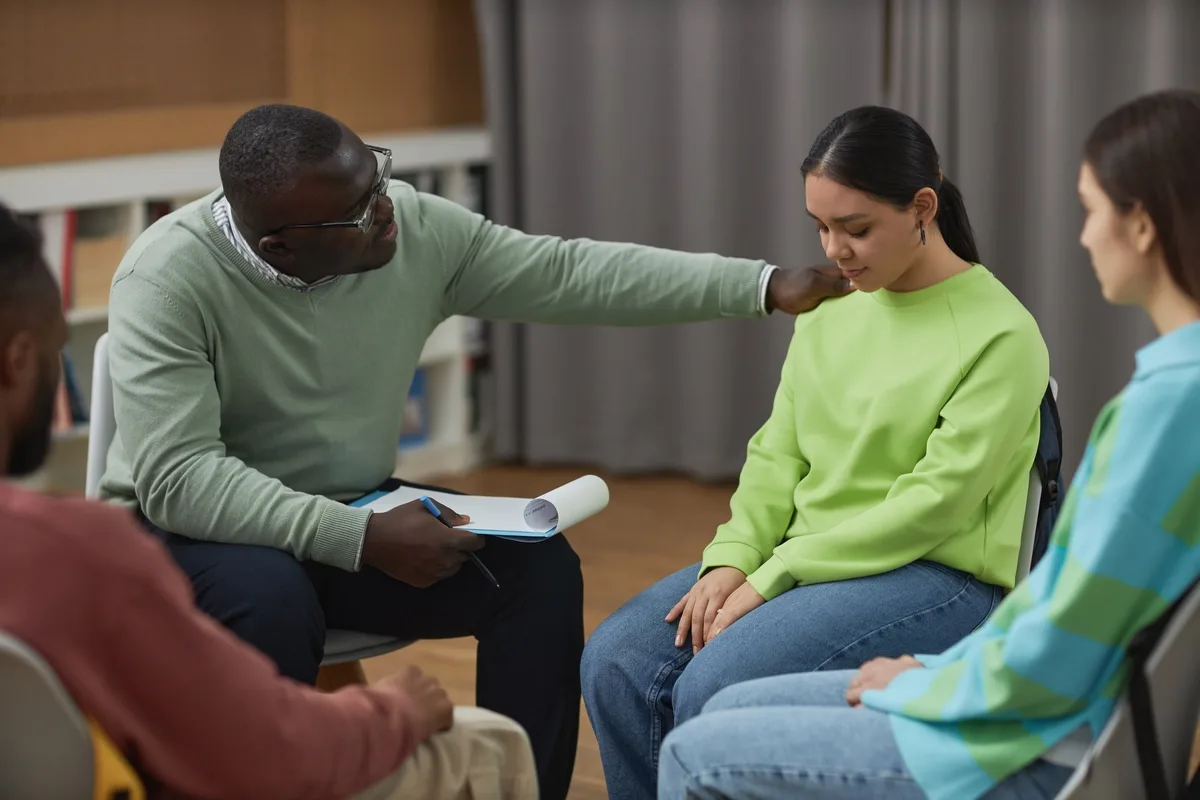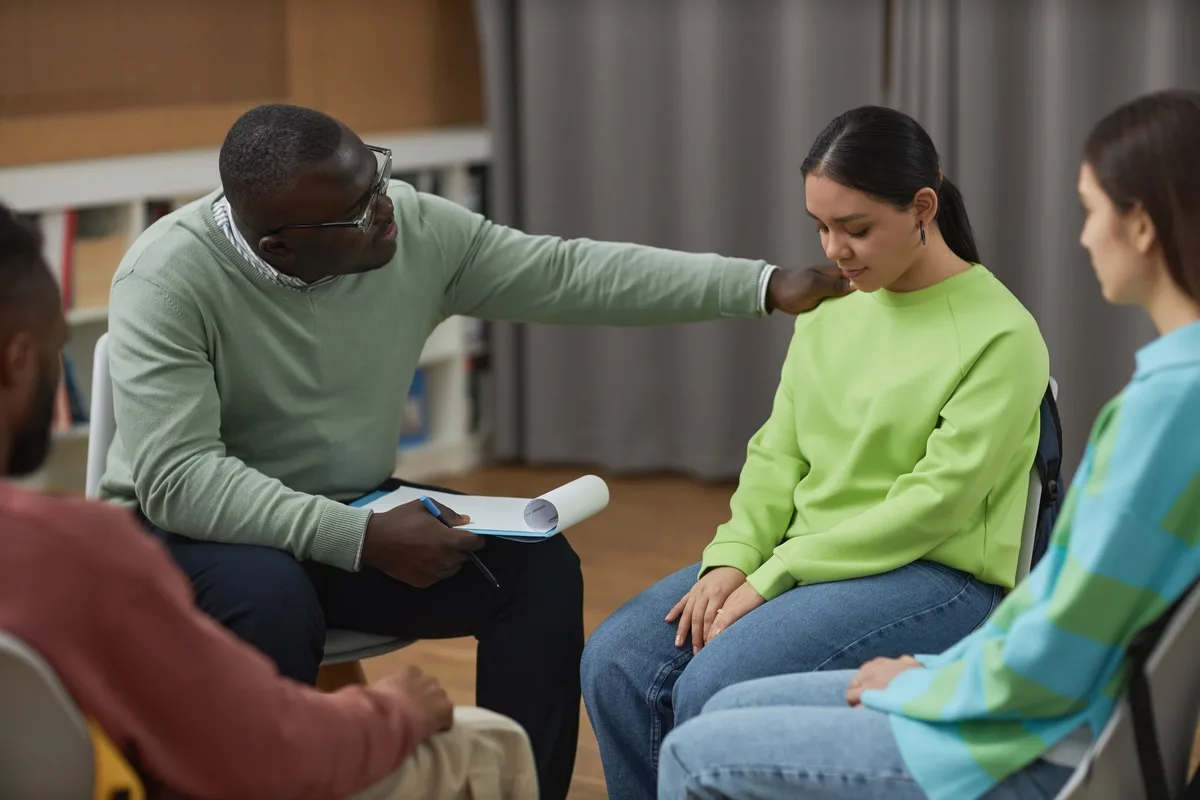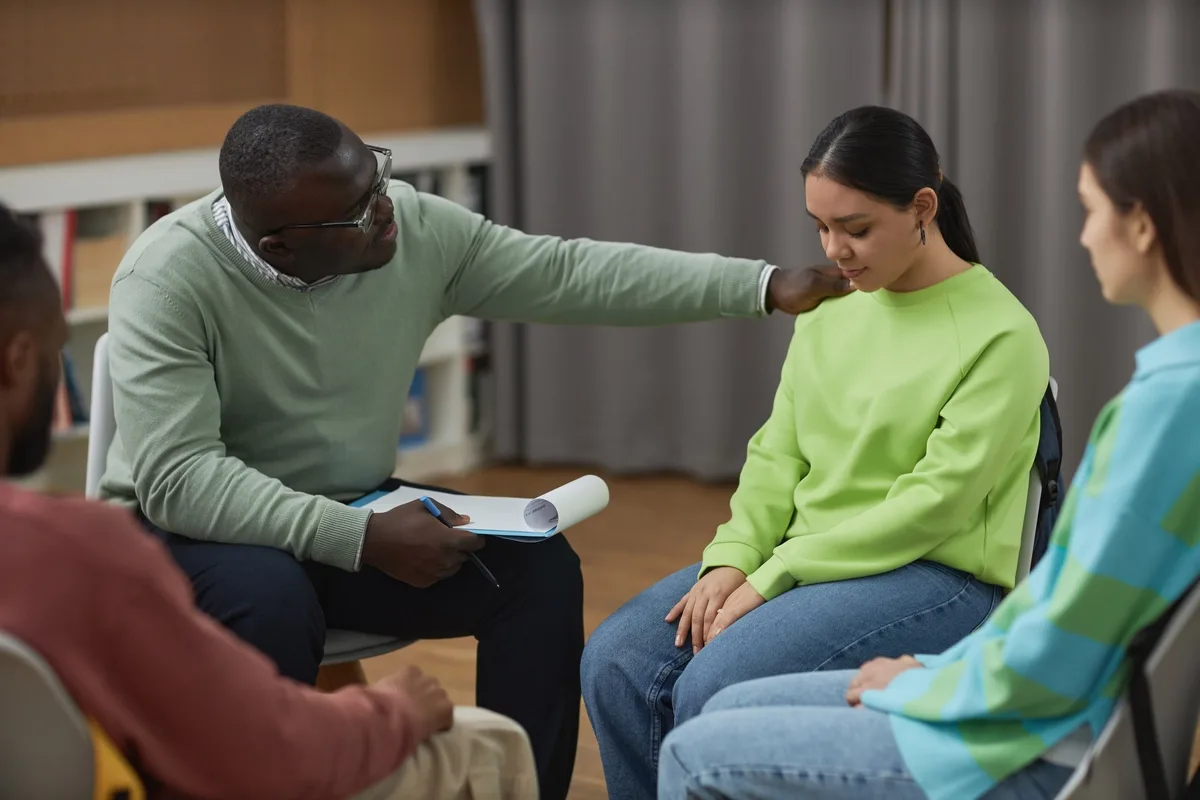24/7 Helpline:
(866) 899-221924/7 Helpline:
(866) 899-2219
Learn more about PTSD Rehab centers in Sacramento County
PTSD Rehab in Other Counties

Other Insurance Options

Anthem

United Health Care

UMR

Covered California

WellPoint

Horizon Healthcare Service

Cigna

Sutter

BHS | Behavioral Health Systems

Evernorth

ComPsych

Molina Healthcare

Medical Mutual of Ohio

Self-pay options

American Behavioral

BlueShield

Holman Group

Aetna

Coventry Health Care

UnitedHealth Group

Diamond House Detox Sacramento
Located in Sacramento, California Diamond House Detox Sacramento provides premier detoxification ser...

Sacramento Recovery House
Sacramento Recovery House is a residential treatment program for men seeking from alcohol and drug a...

Visions Unlimited – Sacramento
Visions Unlimited – Sacramento is a private rehab located in Sacramento, California. Visions Unlimit...

New Dawn Treatment Centers – Men’s Detox
New Dawn Treatment Centers - Men's Detox offer a residential treatment detox for those who need help...

Essential Behavioral Health
Located in Sacramento, California, Essential Behavioral Health provides alcohol and drug rehab servi...

BAART Programs
BAART Programs Sacramento is an outpatient drug rehab for adults in opioid recovery in Sacramento, C...

Turning Point – Community Integrated Services
Turning Point – Community Integrated Services is a private rehab located in Sacramento, California. ...

Effort Counseling Center
WellSpace Health Counseling Center is a private rehab located in Sacramento, CA. WellSpace Health Co...

New Dawn Treatment Centers
New Dawn Treatment Centers offers an intensive outpatient program and partial hospitalization progra...

New Dawn Treatment Centers – Men’s Residential
New Dawn Treatment Centers - Men's Residential offers an inpatient treatment for those women struggl...

New Dawn Recovery Center
New Dawn Recovery Center is a private rehab located in Orangevale, California. New Dawn Recovery Cen...

Another Choice Another Chance
Another Choice Another Chance is a behavioral healthcare organization dedicated to serve youth, adul...

El Hogar Community Services – Guest House Homeless Program
El Hogar Community Services – Guest House Homeless Program is a private rehab located in Sacramento,...

Strategies for Change – Williamsbourgh Drive
Strategies for Change - Williamsbourgh Drive is dedicated to provide substance abuse and co-occurrin...

Gateway House for Women
Gateway House for Women is a rehab facility that provides substance abuse treatment for women strugg...

Clean and Sober Recovery Services
Clean and Sober Recovery Services is a private rehab located in Orangevale, CA. Clean and Sober Reco...

River City Recovery Center
River City is an alcohol and drug addiction treatment center located in Herald, California. Their me...

Clean and Sober Detox
Located in Fair Oaks, California, a quiet town just outside Sacramento, our facility allows for stat...

Terkensha Associates – Grand Avenue
Terkensha Associates – Grand Avenue is a non-profit rehab located in Sacramento, California. Terkens...

Alpha Oaks
Alpha Oaks is a non-profit residential treatment facility for women suffering from addiction founded...

Recovery Happens Counseling Services
Recovery Happens Counseling Services is a private rehab located in Fair Oaks, California. Recovery H...

Cornerstone
Cornerstone is a drug and alcohol rehab that supports women struggling with addiction. Located in Ca...

BAART Programs
BAART Programs is an outpatient clinic who provides methadone treatment and substance use counseling...

Sacramento Veterans Resource Center
Sacramento Veterans Resource Center is a residential, non-for-profit rehab located in Sacramento, Ca...

River City Recovery Center
River City Recovery Center is a residential rehab located in Sacramento, CA. River City Recovery Cen...

New Dawn Treatment Centers
New Dawn Treatment Centers offers an intensive outpatient program for those individuals struggling w...

Valley Recovery Center of California
Valley Recovery Center of California is a multi-addiction treatment center providing progressive ass...

Cedar Point Recovery
Cedar Point Recovery offers inpatient and outpatient services for individuals with alcohol and/or su...

Kiasi Retreats
Kiasi Retreats is a substance use rehab offering a Partial Hospitalization Program (PHP), Intensive ...

Better Decisions Counseling Services
Better Decisions Counseling Services is dedicated to provide Co-parenting, Drug testing services, co...

Azure Acres Recovery Center
Azure Acres Recovery Center stands as a CARF-accredited drug and alcohol rehab center in Sacramento,...

Diamond House Detox
Diamond House Detox is a private rehab located in Elk Grove, California. Diamond House Detox special...

Veritas Counseling Substance Abuse Treatment
Veritas Counseling Substance Abuse Treatment is a private rehab located in Elk Grove, California. Ve...

Teen Challenge – Sacramento Re-Entry Center
Teen Challenge – Sacramento Re-Entry Center is a private rehab located in Sacramento, California. Te...

Valley Recovery Center – Sober Living Program
Valley Recovery Center – Sober Living Program is a private rehab located in Sacramento, California. ...

Sierra Vista Outpatient Services Sacramento
Sierra Vista Outpatient Services Sacramento is a private rehab located in Sacramento, California. Si...

MedMark Treatment Centers
MedMark Treatment Centers stands as a CARF-accredited substance abuse treatment rehab in Sacramento,...

Treatment Associates
Treatment Associates is a private rehab located in Sacramento, California. Treatment Associates spec...

New Dawn Treatment Centers – Women’s Residential
New Dawn Treatment Centers - Women's Residential offers an inpatient treatment for those women strug...

Willingness To Change
Willingness To Change is a non-profit rehab located in Fair Oaks, California. Willingness To Change ...

Crestwood Behavioral Health – Crestwood Center
Crestwood Behavioral Health – Crestwood Center is a private rehab located in Sacramento, California....
































































































































































































AA – Alcoholics Anonymous – Central CA Fellowship
AA – Alcoholics Anonymous – Central CA Fellowship is a non-profit rehab located in Sacramento, Calif...

AA – Alcoholics Anonymous – Latina Central
Alcoholics Anonymous (AA) - Latina Central is a non-profit rehab located in Sacramento, CA. Alcoholi...

Clean and Sober – Homeless Recovery Communities
Clean and Sober - Homeless Recovery Communities is a non-profit rehab located in Sacramento, CA. Cle...

Gifted Healing Center
Gifted Healing Center is a private rehab located in Sacramento, California. Gifted Healing Center sp...

Promise House For Women
Promise House For Women is an eighteen bed exclusive women's facility that provides intensive reside...

Visions Unlimited – Galt
Visions Unlimited – Galt is a private rehab located in Galt, California. Visions Unlimited – Galt sp...

Mexican American Addiction Counseling
Mexican American Addiction Counseling is a private rehab located in Sacramento, California. Mexican ...

AA – Alcoholics Anonymous – Fe y Esperanza
Alcoholics Anonymous is an international fellowship of men and women who have had a drinking problem...

Sobriety Brings A Change – SBAC
Sobriety Brings A Change – SBAC is a non-profit rehab located in Sacramento, California. Sobriety Br...

Life Practice Counseling
Life Practice Counseling is an outpatient rehab located in Sacramento, CA. Life Practice Counseling ...

Preparing People For Success
Preparing People For Success is a private rehab located in Sacramento, California. Preparing People ...

Al – Anon Information Services
Al – Anon Information Services is a non-profit rehab located in Sacramento, California. Al – Anon In...

WellSpace Health – Detoxification Program
WellSpace Health is an accredited drug and alcohol rehab center in Sacramento, CA that offers a cont...

The Gates Recovery Foundation
The Gates Recovery Foundation is a private rehab located in Sacramento, California. The Gates Recove...

Christian Partnership
Christian Partnership is a private rehab located in Sacramento, California. Christian Partnership sp...

Pathways Recovery
Pathways Recovery is a private rehab located in Citrus Heights, California. Pathways Recovery specia...

Turning Point – Integrated Treatment
Turning Point – Integrated Treatment is a private rehab located in Sacramento, California. Turning P...

Volunteers of America
Volunteers of America - Grand Avenue offers inpatient treatment for women with alcohol and/or substa...

D & A Detox
D & A Detox offers substance abuse treatment to adults in need for help. Their services include resi...

Kaiser Permanente – Chemical Dependency
Kaiser Permanente – Chemical Dependency is a private rehab located in Sacramento, California. Kaiser...

Pacific Harbor Treatment
Pacific Harbor Treatment is a private rehab located in Sacramento, California. Pacific Harbor Treatm...

Strategies for Change – Auburn Boulevard
Strategies for Change - Auburn Boulevard is dedicated to provide substance abuse and co-occurring me...

Sacramento Pathway – Pathways Recovery
Sacramento Pathway – Pathways Recovery is a private rehab located in Citrus Heights, California. Sac...

New Dawn Recovery Center
New Dawn Recovery Center is a private rehab located in Folsom, California. New Dawn Recovery Center ...

Sequoia Family Counseling Center
Sequoia Family Counseling Center is a private rehab located in Citrus Heights, California. Sequoia F...

Change
Change offers outpatient treatment for individuals with alcohol and/or substance addiction. The prog...

Sobriety Brings A Change – SBAC – 47th Avenue
Sobriety Brings A Change (SBAC) is a non-profit community based outpatient addiction treatment agenc...

Valley Sober Living
Valley Sober Living is a Sober Living facility for those individuals that are in the early stages of...

Yancey Recovery Services
Yancey Recovery Services is a Outpatient Treatment Program located in Sacramento, California Yancey ...

Bridges Inc Outpatient Services
Bridges Inc Outpatient Services is a private rehab located in Sacramento, California. Bridges Inc Ou...

New Dawn Treatment Centers – Women’s Detox
New Dawn Treatment Centers - Women's Detox offer a residential treatment detox for those who need he...

National Council on Alcohol and Drug Dependency
National Council on Alcohol and Drug Dependency is a private rehab located in Sacramento, California...























































































































































































































